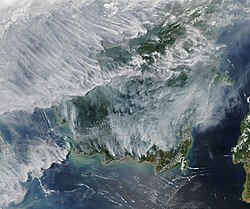| Southeast Asian haze series |
|---|
 |
| History |
| Key topics |
| Responses |
| See also |
|
|

The 2006 Southeast Asian haze was an air pollution event caused by continuous, uncontrolled burning from "slash and burn" cultivation in Indonesia, which affected several countries in the Southeast Asian region and beyond, including Malaysia, Singapore, southern Thailand, and as far away as Saipan;[1] the effects of the haze may have even spread to South Korea.[2] Local sources of industrial pollution also, inadvertently, contributed to increases in air toxicity (particularly in already-polluted areas); notably at-risk areas included communities close to textile factories, fertilizer plants, meat-packing plants, industrialised dairy farms, shipping ports, and oil refineries. Air quality was lower, overall, for residents of more densely-populated cities. In the highly urban and industrialised Klang Valley of Malaysia, in particular, the surrounding elevated terrain acted as a natural retainer of polluted air, aggravating the situation as the haze set in.
There is also a link to El Niño.[3] The haze was made worse than during previous occurrences by the El Niño-Southern Oscillation which delayed the year's monsoon season. Fires in Kalimantan produce great amounts of smoke, burn a long time and are difficult to extinguish because they are on peatland, and once lit the fires can burn for months and release gases that produce sulphuric acid.[4]
Air quality across the region appeared to improve in late October as heavy rainfall doused fires in Indonesia.[5]
- ^ "Indon haze spreads to NMI". saipantribune.com. Archived from the original on 18 February 2007. Retrieved 8 October 2006.
- ^ NASA (13 October 2006). "Haze over Korea". Archived from the original on 3 August 2007. Retrieved 30 October 2006.
- ^ "NASA Data Links Indonesian Wildfire Flare-Up to Recent El Nino". Retrieved 3 January 2007.
- ^ Ghosh, Arijit. 31 October 2006. Fires leave Indonesia's neighbours fuming – Business – Business – theage.com.au, Bloomberg via The Age. Retrieved 1 November 2006.
- ^ "Rain clears haze in SE Asia". Reuters at Yahoo!. Retrieved 29 October 2006. [dead link]